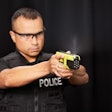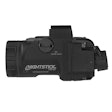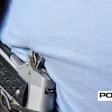For the vast majority of my 10 plus years on a SWAT team it has been my mantra that you train for what you do as a police officer. One aspect of training for what you do is to realize that just because a large big name department does something one particular way doesn't mean it's best for you. Each department faces its own set of unique challenges.
It is critical for you to take what works best for you in your operating environment. An expert's opinion is just that, opinion. Experience lends some credibility, but some of the stupidest and least practical tactics have come from "experts" with a ton of experience. This goes not just for tactics but for equipment as well.
Equipment for the police sniper has become heavily market driven. In some ways that's very bad, in others it's incredibly beneficial. Need may often drive innovation, but money often drives the ability to turn it into reality. The downside being it is often those with the money that drive the advertising. They can end up in the forefront with little regard to the practicality of the gun or item. This can lead to controversy.
In the police sniper world there rages a debate over caliber selection. And I feel well qualified to chime in.
Over my years as a sniper on a SWAT team I have fielded several different calibers of rifles including .308, .300 Win Mag, .300 WSM, .338 Lapua, 338 Norma, .50 BMG, and others. Given my second career in the gun business, I've also had the opportunity to sample rifles ranging in price from $500 to $5,000. Each of them served a purpose and served that purpose well.
The .338's are great for very long range and media penetration. The .300 Win Mag and Short Mag were great competitive rifles. And the venerable .308 has been my work horse over the years and strikes a good compromise for ranges from 50 to 500 yards.
But what about those agencies that never see police sniper engagements beyond even 100 yards? Which is likely substantially more than 95 percent of all police agencies. Big hunting calibers are just not optimal for these agencies' operations because of worries about overpenetration.
Unfortunately, options for smaller precision rifles are limited. The .223 has been tried and has suffered an issue or two with underpenetration and failure to immediately incapacitate the threat. So in most snipers' opinions that leaves the 6.8 SPC and the 6.5 Grendel.
May the Best Round Win
The argument as to which round is better-the 6.8 SPC or the 6.5 Grendel-is as volatile as the typical plastic vs. steel pistol argument, but I figured it needed to be addressed.
So as not to inflame the heated arguments that go back and forth between the 6.8 and the 6.5 crowds let me clearly state my purpose: The focus of this discussion is the viability of the 6.8 SPC cartridge as an urban police sniper round.
But let's look at the 6.5 Grendel. This round is best compared against the .308, and has some promising advantages at longer ranges, especially beyond 300 yards. Which is irrelevant to this discussion.
We are talking about up-close-and-personal work in an urban police environment. Even given the ability to deploy at ranges beyond 100 yards we never did. Most of the time we set up at 50 yards, and there were a couple of times 25 yards was all we had.
So, how flat a round shoots at 500 yards is not even a point of discussion. This is about an alternative to a .308 for those snipers who will likely never even see a 100-yard deployment and do not need the overpenetration or down range effect. I believe the 6.8 SPC is that alternative.[PAGEBREAK]A Proven Round
The 6.8 SPC was designed from the ground up to work as an anti-personnel cartridge in a military environment. It was also designed to work in the AR-15/M16 platform. Given that many if not most agencies are using AR-15s or M16s for patrol and SWAT operations, having a sniper round that can be used in a close-quarter combat carbine is a huge plus. It provides a means for a police sniper to have a primary and secondary weapon in the same caliber.
Entries can be performed with the 6.8 SPC; that is what it was really designed to do. It was not a success in the military world as a whole but that's a bonus for police who want to use it. We don't have to compete with the military for supplies.
And fortunately, the 6.8 SPC has been a hit on the hunting market. The days of hard-to-find ammunition, and in only one bullet size, are long gone. The 6.8 SPC cartridge is now available in factory loadings in all kinds of variety.
Silver State Armory is loading bullets that range from 85-grain TSX to 115-grain OTM. About the only thing I could not truly find was honest match ammunition. Mostly at this point it's due to a lack of market, but getting it loaded to match specifications from a number of manufacturers is probably not an issue.
The last point to consider here is one of the most important. A sniper round must be field proven in its ability to kill quickly. The 6.8 SPC is proven for its ability to take game, and we are not talking about thin-skinned small game here. It can kill big mammals.
Most states won't even let you hunt deer with a .223; it is pretty well limited to varmints. Not so with the 6.8 SPC. On a recent hunting trip, myself and three friends bagged about a dozen wild hogs using ARs. Our prey ranged from 180 pounds to nearly 250 pounds, and all shots resulted in immediate incapacitation at ranges from 80 to 150 yards with a 95-grain TTSX bullet.
The Test Rifles
While I think a long-barrel AR chambered in 6.8 SPC can be used as a sniper rifle in some cases, most snipers prefer a bolt gun. So the final question a lot of snipers have about this round is: How does it work in a bolt-action rifle? To be honest, there aren't many purpose-built bolt-action police sniper rifles available in 6.8 SPC. So a custom rifle had to be used in this test.
I've had the opportunity to test the 6.8 SPC cartridge in several AR-type rifles. And generally they were pretty accurate and potentially very accurate. The 6.8 SPC ARs that I have shot are the Wilson Combat Recon in 6.8 SPC and a Barrett REC7.
The Wilson Combat was tested while hunting and on a range, and it proved to be incredibly accurate and ultimately reliable. The Barrett was actually fielded for quite some time where possible and has been used at every department qualification for the last year. This rifle was a bit pickier about what ammunition was most accurate but with the correct factory ammunition it was very accurate, producing groups well under an inch at 100 yards.
The last platform used in the semi-auto AR test was a Primary Weapons Systems upper that was just built for an upcoming class. This was used for comparison testing on the chronograph, as it has a 12.5-inch barrel.
As noted, the bolt gun is a custom job. It was built for me by Mike's Gun Sales and Service of Aransas Pass, Texas, on a Remington 700 SA and bedded into a McMillan stock. The barrel is a 20-inch stainless, and it is tapered to fit a suppressor that will be attached at a later date. It uses a standard Remington trigger and an AICS magazine inserted in Mike's custom-built bottom metal.
For optics, I fitted this rifle with a Night Force NXS F1 3.5-15x mounted in the company's fantastic rings. I have used this scope on a couple of other guns and it is very consistent. The sister to this rifle built at roughly the same time has printed .75-inch groups with hand loads at 320 yards, so it is as accurate as you can get with this platform.
Acquiring ammunition for this test was not difficult. Silver State Armory provided me with a box or two of all its tactical loads. Some Hornady custom was located for the test as well.[PAGEBREAK]Punching Paper
In the semi-auto guns different ammunition yielded varying results. Groups ranged from as big as a couple inches at 100 yards to just about the same hole with others.
And some guns were really accurate with specific ammunition. For example, the Barrett REC7 really liked the 110-grain Pro Hunter rounds. And using the same ammo, the Wilson Combat yielded a group that would make any precision rifle shooter happy, measuring well under .5 inches. Even with the 12.5-inch barrel the PWS upper yielded a couple of quarter-sized groups with the 85-grain TSX.
With the bolt gun the most accurate round was the 110-grain Accubond with a best group a bit under .5 inches. Everything else went through that bolt gun into groups right around .75 inches or so. Not bad, considering none of it is match grade. The bolt gun was definitely more consistent across the board as you might expect, but the semi-autos are capable of some pretty good accuracy.
Putting the paper targets behind some glass, I decided to give the rounds a tough real-world test. Unfortunately, I only had time to do this with one type of ammunition. Still the results were quite impressive,
The range was 50 yards level to the windshield to require some deflection. The Accubond was tested, as this is our glass round of choice in the department's .308 rifles and this gave me some basis by which to judge the performance of the 6.8 SPC.
My shots went through the windshield and into the paper at pretty much the point of aim. Deflection was insignificant, and I actually saw less spalling with the Accubond 6.8 than I normally do with my department-issued round.The bullet held together on all three shots with no jacket separation. My verdict is that the 6.8 SPC performs just as well as a .308 at 50 yards.
Muzzle Velocity
As one might expect the longer barrel produced the best muzzle velocity results.
Climate conditions on the day of the testing also were a factor. It was a warm day, pushing 90 degrees, pretty windy, and about 30 percent humidity. The range is at about 5,000 feet above sea level.
The fastest round that I tested was the 85-grain TSX, which averaged 3,221 feet per second (fps) out of the bolt gun. All of the other rounds topped out at about 2,700 fps. The 12.5-inch PWS reached 2,470 fps from the TSX, making it a great entry round. For the most part, the velocity difference was about 250 fps between the 20-inch and the 12.5-inch barrel.
Given these muzzle velocity numbers, I have little doubt this round would effect immediate incapacitation with the appropriate shot at any range inside 300 yards, certainly at real-world police sniper distances.
And the 6.8 SPC is a smooth shooter. Even with such high muzzle velocity numbers these rifles have no appreciable recoil. That was especially true of the bolt rifle. With the rifle held properly you can watch your hits.
My testing leads me to the conclusion that the 6.8 SPC is viable as a dedicated urban police sniper rifle cartridge. It's optimized for a 16-inch barrel and that enables an urban shooter to use a more compact sniper rifle or even an AR-style rifle that can double as an entry weapon or patrol rifle. This cartridge has proven itself in the AR platform so a sniper team could easily run both the primary and secondary in the same cartridge and not give away any firepower out to 300 yards.
One major concern is ammunition selection. A variety is available but match rounds would be nice. Still the ammo I tested performed very well and sometimes exceptionally. I recommend TTSX if you need penetration. If you want expansion and bullet retention the 85-grain TSX may be the ticket. The 110-grain Accubond has potential as a glass round and produced some excellent accuracy as well.
One major drawback for the 6.8 SPC as a sniper round is that you won't find purpose-built bolt-action sniper rifles in this caliber. However, custom-made bolt-action rifles can be purchased.
Finally, I don't believe that an operator or officer should ever take the word from an "expert" that he or she needs to change equipment. You have to match your equipment to your mission and your environment. So I don't want you to rush out and adopt the 6.8 SPC as your sniper round just because I say so. However, if you're looking to make a change, do your own test. You may really like the results.
Lt. Dave Bahde is a 20-year veteran of South Salt Lake (Utah) PD and an experienced SWAT team leader, SWAT sniper, and firearms instructor.
FOR MORE INFORMATION:















